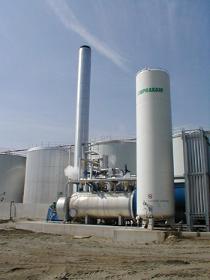- europages
- >
- COMPANIES - SUPPLIERS - SERVICE PROVIDERS
- >
- post combustion
Results for
Post combustion - Import export

EUROPEM
Belgium
The HI Incinerator features a combustion chamber with a mixing wall which divides this chamber into a high temperature combustion HI zone and a lower temperature post-combustion zone. This particular configuration is most suited to the fuel efficient combustion of lean waste gases and effluents, as it reduces the need for any support fuel. Key Features - Combustion chamber with mixing wall – High intensity combustion zone at elevated temperatures – Waste gases and liquids are delivered to the HI zone through the burner and a series of injection lances. – The mixing wall creates a high temperature zone around flame ensuring complete oxidisation and also to increase turbulence, thus avoiding cold spots and the formation of CO – Post-combustion zone after the mixing wall to ensure residence time of 2 seconds at >850°C Key Advantages - All hydrocarbons are destroyed – No CO formation – Complete odour destruction – Up to 20% fuel saving – Destruction efficiency over 99.99%
Request for a quote
EUROPEM
Belgium
Rotary kiln incinerators are the workhorse of industry to burn solid waste in combination with sludge, waste gas and/or waste liquids and where the rotating motion transports the solid burning waste through the incinerator. Ashes are collected at the end of the rotating kiln and then combustion gases are completely oxidised in the static post combustion chamber. Rotary kiln incinerators typically feature different types of solid waste feeding systems for the bulky solid waste, containers and drums such as feeding screws and ram feeders. Waste gases and liquids are either injected into the rotary kiln, or the (vertical) post combustion chamber behind the rotary kiln. It provides for flexible and versatile incineration technology, but is characterised by a lower thermal efficiency with the associated higher operating and maintenance costs. Key Features Rotary kiln furnace with pre-set inclination and variable rotation speed. Labyrinth type seal with cooling and/or flushing with inert gas Different feeding systems for solid waste, waste liquids and waste gases Can be operated in a reducing or oxidizing environment Different drive mechanisms such as chain or direct drive, depending on the size of the kiln and the capacity Key Advantages - Robust and flexible design to burn a wide range of waste fractions – Proven technology – Destruction efficiency over 99.999% and less than 3% carbon in the ashes – Low NOx and CO emissions possible – Flue gas treatment train needed to meet acid, heavy metal, dust and PCDD/F emission levels
Request for a quote
EUROPEM
Belgium
A Redu-reox incinerator features three reaction chambers for the low NOx combustion of waste streams and fuels with a high organically bound Nitrogen content. In the first reaction chamber a reducing environment is maintained to ensure that any free Oxygen will react with Hydrogen to form water. No Oxygen is left to combine with Nitrogen to form NOx. Complete combustion is achieved in the re-oxidation chamber, after the gases have been cooled in the quench stage. The temperature in the re-oxidation chamber is below 950°C to ensure that any Oxygen reacts with Carbon and Hydrogen and not Nitrogen, to minimize formation of thermal NOx. Key Features Three reaction chambers with staged combustion and intermediate flue gas cooling. First chamber operating under a reducing atmosphere at a temperature above 1250oC. Second chamber to quench the flue gases to about 800°C by either injection of steam or recirculated flue gas. Third or re-oxidation chamber for the post-combustion of remaining waste components at temperatures above 900oC. Key Advantages - Ultra-low NOx combustion of waste streams with high bound Nitrogen contents. – Complete oxidation with all hydrocarbons destroyed – No CO formation – Complete odour destruction – No need for SNCR or SCR deNOx to meet emission limits – Destruction efficiency over 99.999%
Request for a quote
HAMON
Belgium
Selective Non-Catalytic Reduction is a post-combustion technology that is designed to control nitrogen oxides (NOx) emissions from boilers by the injection of ammonia or urea reagents into the flue gas.Hamon Research-Cottrell is licensed by Exxon Mobil for the application of ammonia based Thermal DeNox™ (TDN).
Request for a quoteDo you sell or make similar products?
Sign up to europages and have your products listed
Results for
Post combustion - Import exportNumber of results
4 ProductsCountries
Company type
Category